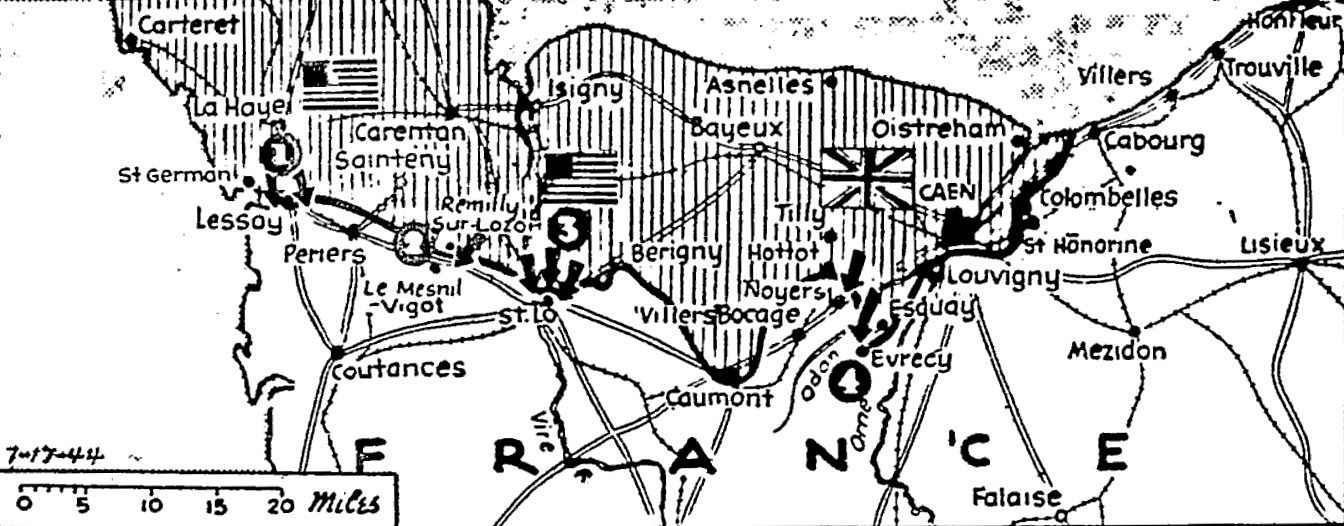Innsbrucker Nachrichten (July 17, 1944)
Englischer Großangriff bei Caen zurückgeschlagen
Heftige Abwehrschlacht im Südabschnitt der Ostfront – Bandenzentrum auf dem Balkan gesäubert – Anglo-amerikanische Terrorangriffe
dnb. Führerhauptquartier, 17. Juli –
Das Oberkommando der Wehrmacht gibt bekannt:
Südwestlich Caen traten englische Divisionen gestern erneut zum Großangriff an. Schwerstes Artilleriefeuer von Land und von See her unterstützte die feindlichen Angriffe. Es gelang dem Gegner, in einige dicht hinter unseren Linien liegende Ortschaften einzudringen. Sofortige Gegenstöße unserer Reserven warfen ihn zurück. In einer Einbruchsstelle wird noch gekämpft. 58 Panzer wurden dort abgeschossen. Im Raum von Saint-Lô und im Abschnitt westlich der Vire führte der Gegner Infolge der hohen Verluste an den Vortagen nur schwächere Angriffe, die erfolglos blieben.
Vor der niederländischen Küste beschädigten Vorpostenboote ein britisches Schnellboot schwer. Mit seinem Untergang ist zu rechnen.
Bei einem Säuberungsunternehmen im südfranzösischen Raum wurden 460 Terroristen im Kampf niedergemacht.
Das schwere Feuer der „V1“ liegt weiterhin auf dem Großraum von London.
In Italien lag der Schwerpunkt der Kämpfe gestern nordöstlich Volterra, bei Arezzo und beiderseits des Tiber. Während alle mit zusammengefassten Kräften geführten Angriffe verlustreich für den Feind abgewiesen wurden, gingen die Trümmer der Stadt Arezzo nach erbittertem Kampf verloren.
Sicherungsfahrzeuge der Kriegsmarine schossen vor der italienischen Westküste ein britisches Schnellboot in Brand und zwangen weitere zum Abdrehen.
Im Südabschnitt der Ostfront nahm die Abwehrschlacht östlich des oberen Bug an Heftigkeit zu. In schweren wechselvollen Kämpfen wurden die aus dem Raum von Tarnopol und Luzk angreifenden sowjetischen Panzerkräfte aufgefangen. In den beiden letzten Tagen wurden hier 125 feindliche Panzer vernichtet.
Zwischen Pripjet und Düna hielten die harten Kämpfe auf breiter Front an. Am Njemen vereitelten unsere Divisionen mehrere Durchbruchsversuche der Bolschewisten. Bei Grodno setzten sich unsere Truppen nach planmäßiger Räumung der Stadt auf das Westufer des Njemen ab.
Im Seengebiet südlich der Düna brachen wiederholte Angriffe des Feindes verlustreich zusammen. Zwischen Düna und Peipussee scheiterten auch gestern zahlreiche Angriffe der Sowjets. Nur im Einbruchsraum südlich Opotschka konnte der Feind nach wechselvollen Kämpfen Boden gewinnen.
Die Luftwaffe griff an den Schwerpunkten mit starken Schlachtfliegergeschwadern in die Abwehrschlacht ein und fügte den Bolschewisten in Tiefangriffen hohe Verluste zu. Zahlreiche Panzer, Geschütze und über 400 Fahrzeuge des Feindes wurden vernichtet. In heftigen Luftkämpfen wurden 88 feindliche Flugzeuge, durch Flakartillerie 9 weitere abgeschossen.
Auf dem Balkan wurde ein größeres Bandenzentrum nach harten Kämpfen gesäubert. Die Kommunisten verloren weit über 1400 Tote und zahlreiche Gefangene. Zahlreiche leichte und schwere Waffen, 19 Lager sowie große Mengen an Munition und Kriegsgerät aller Art wurden vernichtet oder erbeutet.
Vor der südnorwegischen Küste schossen Sicherungsfahrzeuge eines deutschen Geleits und Bordflak von Handelsschiffen sechs britische Bomber ab.
Nordamerikanische Bomberverbände griffen mehrere Orte in Süd- und Südwestdeutschland an, unter anderem Saarbrücken, Augsburg und mit stärkeren Kräften München. Besonders in München, gegen das der Feind innerhalb von fünf Tagen bei für die eigene Abwehr ungünstiger Wetterlage vier Großangriffe führte, entstanden zum Teil empfindliche Schäden und Verluste. Die Haltung der Bevölkerung war vorbildlich.
Ein, weiterer von Süden einfliegender nordamerikanischer Bomberverband griff Wien an. Auch hier entstanden Schäden im Stadtgebiet und Personenverluste. Durch Luftverteidigungskräfte wurden 43 feindliche Flugzeuge vernichtet.
In der Nacht warfen einzelne britische Flugzeuge Bomben im rheinisch-westfälischen Raum.

